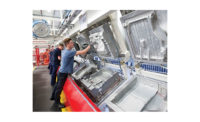Slowly but surely, the economy is recovering from the Great Recession.
U.S. factory output surged 0.7 percent in August, according to the Federal Reserve. The gains were led by a 5.2 percent increase in automotive assemblies—the largest increase since November 2012. The auto industry is now on pace to produce 11.25 million units for the year, the highest level since June 2007.
The Fed also reported increases in the production of consumer goods, high-tech equipment, machinery, aerospace, electrical equipment and appliances. Since August 2012, overall factory output is up 2.6 percent.
More good news: According to the Commerce Department, groundbreaking for single-family homes, the largest segment of the housing market, increased 7 percent in August to a seasonally adjusted annual rate of 628,000 units, the highest since February.
And, according to the Labor Department, the economy added 169,000 jobs in August, a modest gain. The U.S. unemployment rate was 7.3 percent, the lowest level since November 2008.
While such numbers are certainly welcome, there’s still plenty of room for economic improvement. Hyun Song Shin, Ph.D., an economics professor at Princeton University, thinks he knows why growth has been so disappointing over the past four years.
The nation’s biggest companies rely on stock and bond markets for financing, and those markets have improved a lot after years of interventionism from the world’s central banks. In contrast, small and midsized companies rely more heavily on the banking system, Shin argues.
So what’s happening with the price and availability of bank lending? Historically, the interest rate on bank loans to businesses is typically 2 to 3 percentage points higher than whatever the Federal Reserve’s target interest rate is at any given time. But when the financial crisis began and the Fed cut its interest rate to zero, lending rates didn’t fall—they got higher. The difference between bank rates and the Fed rate is now 4 to 5 percentage points. (This rate difference is even worse in Europe, Shin points out.)
So despite the Fed’s efforts, interest rates for manufacturers wanting loans to build new assembly plants or buy new equipment are still awfully high.
And yet even with the potential to make more interest, banks aren’t lending. According to Shin, credit to corporate businesses, which rely heavily on bonds, has been rising since 2010, from around $7 trillion to $8 trillion. In fact, it has surpassed precrisis levels. Meanwhile, for noncorporate businesses, which rely heavily on mortgages and loans, lending remains below precrisis levels.
In short, the types of businesses that are crucial to job creation have less total credit, and when they get a loan it is at much higher interest rates. For the U.S. economy to really get humming, that trend needs to be reversed. Give credit where credit is due.


